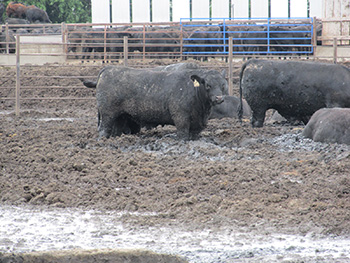Watch for footrot following excessive rain, subsequent wet conditions
7/1/24
CHARITON, Iowa – Beyond the obvious and immediate challenges of excessive rainfall, wet weather may predispose livestock to a painful infection called footrot. Footrot is a bacterial infection of the foot characterized by swelling and pain, often in the interdigital space, and associated lameness. Iowa State University extension beef specialist Chris Clark said that following a wet spring and recent storms and flooding, there may be a greater risk for this disease in Midwestern cattle herds.
"Prolonged wet, muddy conditions can cause softening and thinning of the interdigital skin, which can allow bacteria to enter," he said. "When weather challenges lead to standing water, saturated pastures, deep mud, etc. that increases the risk for this disease. Producers should watch closely for acute lameness and be prepared with a treatment plan and needed supplies.”
Accurate diagnosis is key, along with appropriate and timely therapy. Systemic antibiotics are used for treatment and several available drugs are labeled for treatment of footrot. It is essential to have a valid veterinary client-patient relationship to get access to these prescription drugs, and it's important to follow label directions, including recommended dose, administration route, and withdrawal time.
“Lameness cases require some time and effort to pick up the feet and get an accurate diagnosis," Clark said. "Footrot is relatively easy to diagnose based on clinical signs, although there are other infections of the foot that need to be differentiated. Toe abscesses, white line disease, digital dermatitis, and foreign bodies are some other common causes of foot pathology and lameness."
Early identification and treatment are key, because in some cases, the infection can penetrate deeper structures of the foot, such as bones, tendons, and joints. Prognosis is much worse when those deeper tissues are affected.
"Pen maintenance is a key to prevention, but producers can only do so much to keep up with Mother Nature," Clark said. "In more normal weather, appropriate stocking density, regularly scraping aprons and feedlot surfaces, and sometimes the use of bedding can all be helpful. But when rainfall is extreme, it is sometimes impossible to maintain those pen conditions.”
Footrot can affect both feedlot and cow-calf operations. In feedlot settings, pen maintenance is the biggest key to prevention. Here are some suggestions to help avoid footrot in cow-calf settings.
- Consider moving cattle out of low ground and bottom pastures until conditions are drier.
- Reinforcement and maintenance of high-traffic areas to prevent mud and pooling of water can also be helpful.
- Regularly moving mineral feeders, rotational grazing, and placing obstacles in cow paths can all help to minimize high-traffic areas that could get muddy.
- Strive to fence cattle out of ponds and streams. This will help protect banks and riparian areas, while also minimizing loafing in the water during heat stress.
- Provide plenty of fresh, clean water and shade to help mitigate heat stress and reduce the desire to stand in bodies of water.
Producers should scout regularly for signs of lameness, and work with their veterinarians to be fully informed and prepared.
For more information on footrot, download this ISU two-page publication Foot Rot in Beef Cattle, PM 1728 at no charge.
Contact Clark with questions by email at caclark@iastate.edu or by phone at 712-250-0070.
-30-
The Iowa Beef Center at Iowa State University was established in 1996 with the goal of supporting the growth and vitality of the state’s beef cattle industry. It comprises faculty and staff from Iowa State University Extension and Outreach, College of Agriculture and Life Sciences and College of Veterinary Medicine, and works to develop and deliver the latest research-based information regarding the beef cattle industry. For more information about IBC, visit www.iowabeefcenter.org.
Contact:
Chris Clark, Iowa State University Extension beef specialist, 712-250-0070, caclark@iastate.edu

